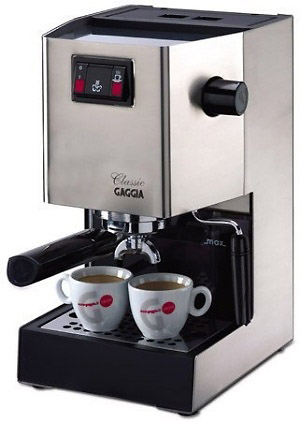Reading this story I thought about this little Gaggia for your Christmas gif… I have the same coffee machine at home… Amazing! What do you think?
 “Languages,” Charles Dickens observed in Martin Chuzzlewit, “are like many other travellers ordinary and commonplace enough at home, but specially genteel abroad.”
“Languages,” Charles Dickens observed in Martin Chuzzlewit, “are like many other travellers ordinary and commonplace enough at home, but specially genteel abroad.”
He was referring to two genteel sisters in New York singing songs in various foreign languages but I think the same point can be made about single words.
Most of us feel the need, now and again, to drop a foreign word into the conversation because it sounds chic or au courant (though it may in fact sound simply affected) .
Take latte, for example. Words don’t come much more ordinary and commonplace than milk, yet Anglophones worldwide now understand latte to be an upmarket extra milky cappuccino. Then there’s bar (as in pub, etc).
The English bar migrated into Italian a long time ago (end of the 19th century, actually) as an alternative to a caffè (cafe not coffee in this case) and no doubt added a certain je ne sais quoi to the first establishments to adopt it.
And what are we to make of barman and barista? In English, a barman works in a bar just as a barista does in Italy. A barman in Italy, however, is a cut above a puller of pints and specialises in cocktails, whilst a barista in English is trained in everything to do with coffee. In my own little way, I’ve recently become a bit of a barista myself (but not a barmaid).
This came about when a concatenation of serious domestic inconveniences (my cooker not cooking, the camping stove running out of gas, and my little electric moka unaccountably dead and found to be replaceable only with a six-cup or 12-cup version) led to a moment of monetary madness œ199.99 spent on a domestic espresso machine.
A Gaggia, approximately 14 inches high x 8 wide x 9« deep, together with a CD called “Barista Training”.
I didn’t linger too long on the actuarial arithmetic of how much that was going to add to the cost of every single cup of coffee I’ll ever drink having good coffee was the important, the really urgent thing.
Well, the coffee is good and breakfast chez moi was breakfast again.
To begin with, the Gaggia’s black and stainless-steel livery seemed a bit aggressive in my not-very-hi-tech kitchen, but now I’d say it’s not only earning its keep but cuts rather a dash. It really does look the business. Learning how to use it didn’t take very long, though it was a little alarming to begin with since the handbook has a list of 24 parts and seven pages of instructions.
Slotting the filter holder into the brewing head in a single movement took a little practice but that’s the bit that makes you feel like a barista. That, and frothing the milk. The reason coffee made in an espresso machine is so good is because the water drives down through the coffee grains instead of rising up through them as it does with a moka.
This downward pressure extrudes more caffeine and tannin and also, of course, forms the little crown of crema. (And, yes, in English barista speak, crema is the correct word.) Historical P.S there was once a vogue for espresso machines that you put on top of the cooker.
My parents had one called the Vesuviana (see photo). The water went into the container on the left, the container was screwed tight, the water boiled under pressure, crossed the bridge and dripped through the coffee holder.
These machines fell out of favour because they were made of aluminium.
0 Comments